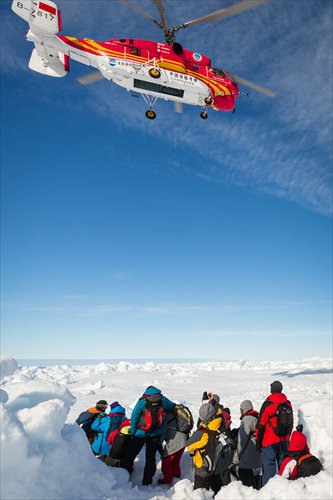Antarctic rescue succeeds

A helicopter from the nearby Chinese icebreaker Xuelong hovers above passengers from the stranded Russian ship Akademik Shokalskiy on Thursday. Photo: AFP
A helicopter from the Chinese icebreaker Xuelong took all 52 passengers from the ice-bound Akademik Shokalskiy in the Antarctic and transferred them safely to the Australian Antarctic supply ship Aurora Australis on Thursday, according to the Australian Maritime Safety Authority (AMSA).
"The Aurora Australis has advised AMSA that the 52 passengers from the Akademik Shokalskiy are now on board," AMSA said on Thursday through its official twitter account.
The 52 Passengers, including scientists and tourists, were flown to the Australian ship in groups of up to 12 by Xueying 12, a helicopter on board China's icebreaker Xuelong.
AMSA, which is coordinating the rescue mission, reported all passengers were safe onboard the Aurora Australis.
"We've made it to the Aurora Australis safe and sound. A huge thanks to the Chinese and the Australian Antarctic Division for all their hard work," expedition leader Chris Turney tweeted on Thursday.
The Polar Research Institute of China on Thursday confirmed to the Global Times that polar helicopter Xueying 12 with Chinese scientific ship Xuelong rescued the passengers from the stranded Akademik Shokalskiy.
An official from the Shanghai-based institute said that while the Xuelong was carrying out China's 30th scientific expedition to Antarctica, it received a message from Australian rescue authorities that Russia's Akademik Shokalskiy was trapped in ice with 74 people on board.
"At first, there were three ships - China's Xuelong, a French icebreaker and Australia's Aurora Australis - heading to the Akademik Shokalskiy and the Xuelong was the nearest," said the official.
"The French icebreaker planned to reach the stranded ship, but its engine got a problem midway and it was forced to quit the rescue."
The official said it was hard for the icebreaker to approach the Akademik Shokalskiy due to bad weather conditions and thick ice before finally the rescue team decided to evacuate passengers by helicopter.
Qu Tanzhou, an official at China's State Oceanic Administration, told the Global Times that the evacuation had been delayed because of strong winds and low visibility making it unsuitable for the helicopter to lift off.
"The weather on Thursday turned out to be better and the helicopter managed the evacuation," said Qu.
According to Qu, two helipads were separately carved out on two pieces of ice near the Akademik Shokalskiy and the Aurora Australis, which allowed the Chinese helicopter to transport the passengers between the two ships.
As it is summer in Antarctica now, night is as bright as day, so rescuing flights can be made nonstop, Igor Kiselev, captain of the Akademik Shokalskiy, said after the first group of 12 passengers was airlifted at 3:25 pm Beijing time, the Xinhua News Agency reported on Thursday.
The Russian ship left New Zealand on November 28 to commemorate the 100th anniversary of an Antarctic journey led by famed Australian explorer Douglas Mawson.
The passengers included tourists, scientists and journalists.
It became trapped on December 24, 100 nautical miles (185 kilometers) east of French Antarctic station Dumont D'Urville and about 1,500 nautical miles south of Australia's southern island state of Tasmania.
Qu said that, currently, the 22 crew of the Akademik Shokalskiy would remain onboard the ship.
"Generally speaking, the crew of the ship would wait for the melting of the ice or wait for a more powerful icebreaker to help the ship out," said Qu, adding that Xuelong has not decided whether it will attend the next stage of any rescue as it will now continue its own scientific research mission in the Antarctic.
According to AFP, it will be some weeks before the passengers reach dry land as the Aurora Australis needs to refuel at Australia's Casey Antarctic base.
Agencies contributed to this story